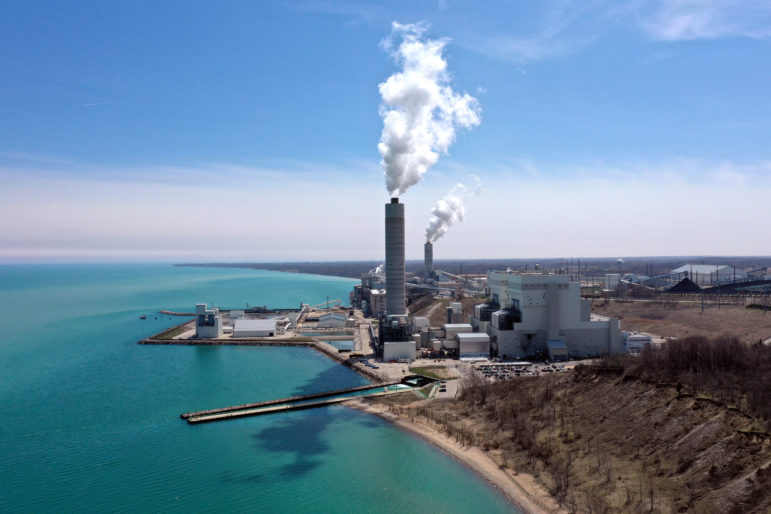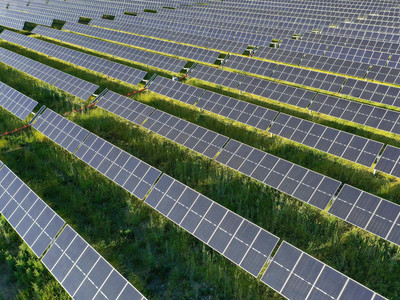State Utilities Falling Short on Carbon Reduction
Behind on 2030 goals. We Energies coal plants will remain in longer than projected.

The plants, in Oak Creek, Wis., near Milwaukee, are coal-fired electrical power stations. Coburn Dukehart/Wisconsin Watch
Wisconsin’s five largest electric utilities are on track to cut carbon emissions 45 percent by 2028, but most will fall short of their 2030 carbon reduction goals.
Those are the findings of the latest draft Strategic Energy Assessment that’s conducted every two years by the Public Service Commission.
Joe Fontaine, the commission’s energy policy advisor, noted their draft review only extends until 2028.
“There may be more work to come from those utilities, in terms of retirements, additions, other changes to their operations that are going to help them make further progress,” said Fontaine.
The draft assessment was released just before Alliant Energy and We Energies announced three Wisconsin coal plants would remain online longer than anticipated amid supply chain constraints and fears of an energy shortage next year. The commission has asked utilities to provide updated data on how delayed retirements and solar additions may affect utilities’ plans for carbon reductions.
If retirements move ahead as planned, coal will make up 22 percent of the state’s power mix by 2028 — down from 35 percent in 2020. Utilities plan to retire around 3,300 megawatts of fossil-fueled generation in the next six years. Those retirements include three of seven coal facilities still running in Wisconsin: South Oak Creek, Edgewater and Columbia.
The state’s five investor-owned utilities have pledged to go carbon-neutral in their power mix by 2050 in line with Gov. Tony Evers’ goal.
Xcel Energy is expected to see the largest emission reductions of 78 percent by 2028, which is just shy of its goal to cut carbon emissions 80 percent by 2030. The utility was the first in the nation to pledge it would provide 100 percent carbon-free electricity by 2050.
“We are confident we will achieve our goal as we continue to expand our diverse resource mix by adding record levels of renewable energy such as wind and solar, the continued use of carbon-free nuclear and retiring the last of our coal plants in the Upper Midwest by 2030,” Chris Ouellette, an Xcel spokesperson, said in a statement.
Following close behind, Madison Gas and Electric is anticipated to cut emissions 70 percent by 2028.
Of the state’s largest utilities, only Alliant is expected to exceed its goal to cut carbon emissions in half by the end of the decade, reducing carbon pollution 62 percent by 2028. Alliant plans to eliminate all coal by 2040.
Wisconsin Public Service and We Energies will make the least progress in cutting carbon emissions, falling roughly 25 to 30 percent below their 80 percent carbon reduction goals. WEC Energy Group, parent company for the two utilities, intends to drop coal from its power mix by 2035.
“We remain confident that we’ll be able to meet our goal to reduce carbon emissions 60 percent by the end of 2025 and 80 percent by the end of 2030,” said Conway. “This report as it stands today … it’s really just a snapshot in time.”
The Biden administration set an ambitious goal for the power sector to reach net-zero emissions by 2035. The president’s climate goals will face more hurdles now that the U.S. Supreme Court has limited the U.S. Environmental Protection Agency’s ability to regulate emissions from power plants.
For the first time, Fontaine noted the PSC obtained a more detailed picture of utilities and their planning process tied to the commission’s investigation of the transition to zero-carbon electricity. The commission found plans to retire coal plants and build renewable energy projects strike a balance with maintaining affordability, reliability, adequate power supplies and emission reductions over the next six years.

The first 150 megawatts of the 300-megawatt Badger Hollow solar farm went online on Dec. 1, 2021. Wisconsin Public Service and Madison Gas and Electric own the project, which was developed by Invenergy. The first phase is expected to power 45,000 homes. Photo courtesy of Wisconsin Public Service/WPR.
Beyond that, Fontaine said utilities face greater challenges with reaching net-zero emissions.
“The costs of doing so are likely to be pretty high because of the builds that you need to do to maintain ongoing reliability if you’re looking forward to 2035 or 2050,” said Fontaine.
Tom Content, executive director of Wisconsin’s Citizens Utility Board, said one outlier is the global spike in gas prices.
“The energy transition was a lot easier to execute when natural gas prices were much lower,” said Content, noting analysts are already projecting higher heating bills this winter.
Even with higher gas prices, Fontaine said commission modeling still favors natural gas as part of the state’s future power mix because of its ability to be quickly dispatched when needed and maintain reliable power.
Natural gas would make up a larger share of the state’s energy mix over the next six years, increasing from 33 to 36 percent of Wisconsin’s power generation. However, environmental groups have opposed utilities’ plans to add natural gas facilities, highlighting their contribution to carbon and methane emissions. Methane is 80 times more potent than carbon dioxide at trapping heat in the atmosphere.
Over the next six years, Wisconsin electric utilities plan to add 2,500 megawatts of solar power, 400 megawatts of natural gas, 500 megawatts of battery storage and 100 megawatts of wind. The share of power from renewable energy would increase to nearly 20 percent, including 13 percent from wind and 6.5 percent from solar. In addition, renewable installations owned by customers now account for 2 percent of the state’s overall capacity.
Moving forward, Fontaine said utilities are projecting minimal increases in demand for power, noting electricity sales have remained relatively flat since the 2008 recession.
“Focus on Energy has been a major contributor to controlling that demand over time and thereby reducing cost to customers,” said Fontaine.
Even so, electric rates for Wisconsin residential customers have been higher than the Midwest and national average for almost two decades. The average charge for residential customers is roughly 14 cents per kilowatt-hour compared to the Midwest and national average of 13 cents per kilowatt-hour.
“That continues to be an ongoing challenge for Wisconsin,” said Content.
While rates are high, the commission said federal data shows average monthly electric bills remain lower than other states largely due to lower energy use. Wisconsin’s customers had an average monthly bill of $99.42 while the Midwest average is closer to $107.02 and the national average hovers around $117.46.
On average, Wisconsin customers pay nearly 6 percent of their income on electricity and gas. Using federal data, a University of Wisconsin-Madison analysis found 18 neighborhoods across the state have energy burdens of 8 percent or more, including nearly a dozen Black and Hispanic communities in Milwaukee County. In rural areas, Menominee, Marinette, Clark, Burnett and Adams counties also paid a greater proportion of their income on energy costs.
The state’s five largest utilities already offer low-income assistance programs to help customers afford their utility bills, as well as refer customers to government and community assistance programs. Conway noted We Energies donated $4 million to the Keep Wisconsin Warm/Cool Fund last year.
The Public Service Commission is accepting public comment on the draft assessment through August, and a final assessment will be released this fall.
Listen to the WPR report here.
Wisconsin’s largest utilities make carbon reduction gains, but most will fall short of 2030 goals was originally published by Wisconsin Public Radio.



















